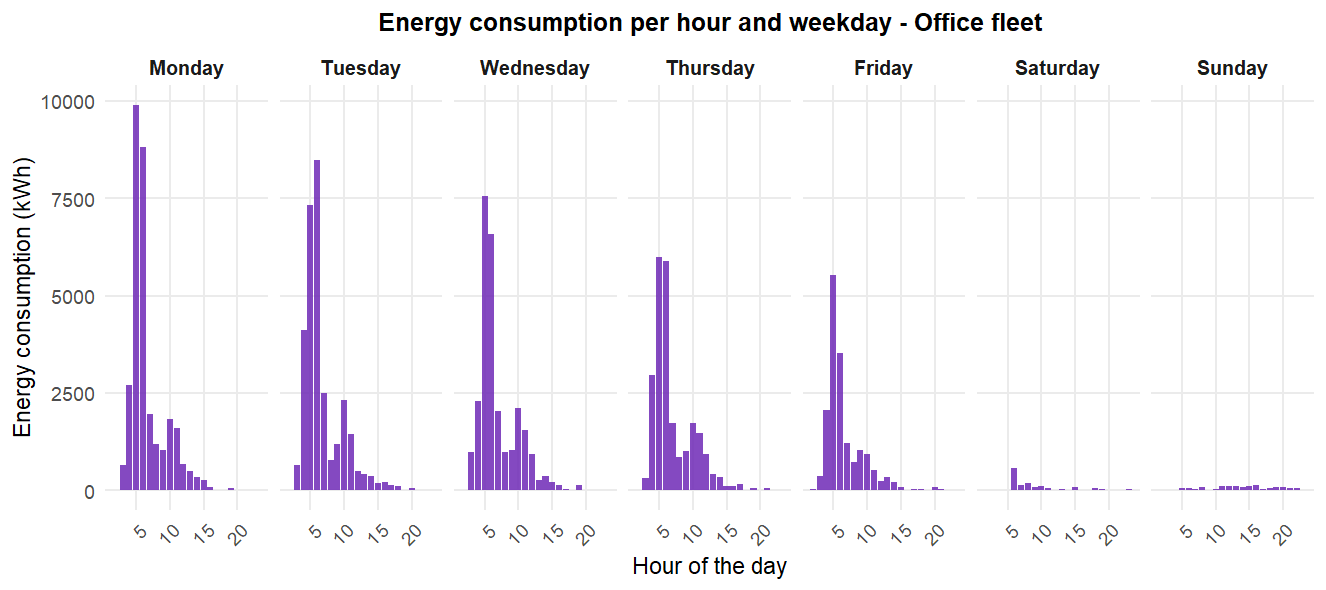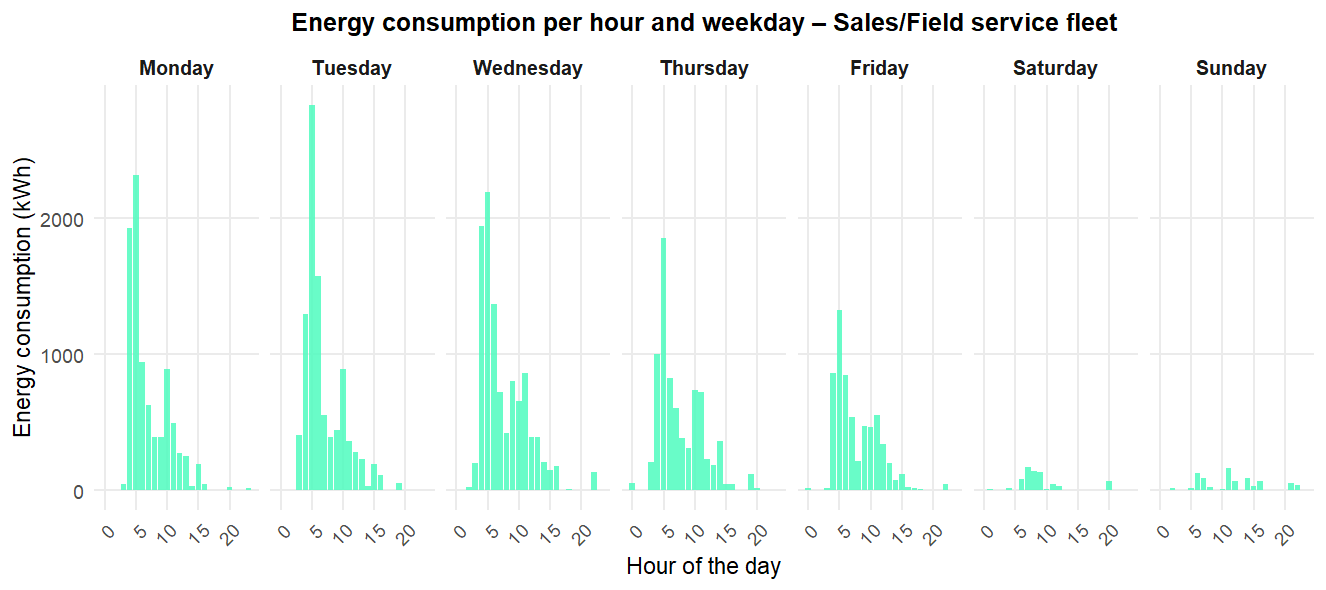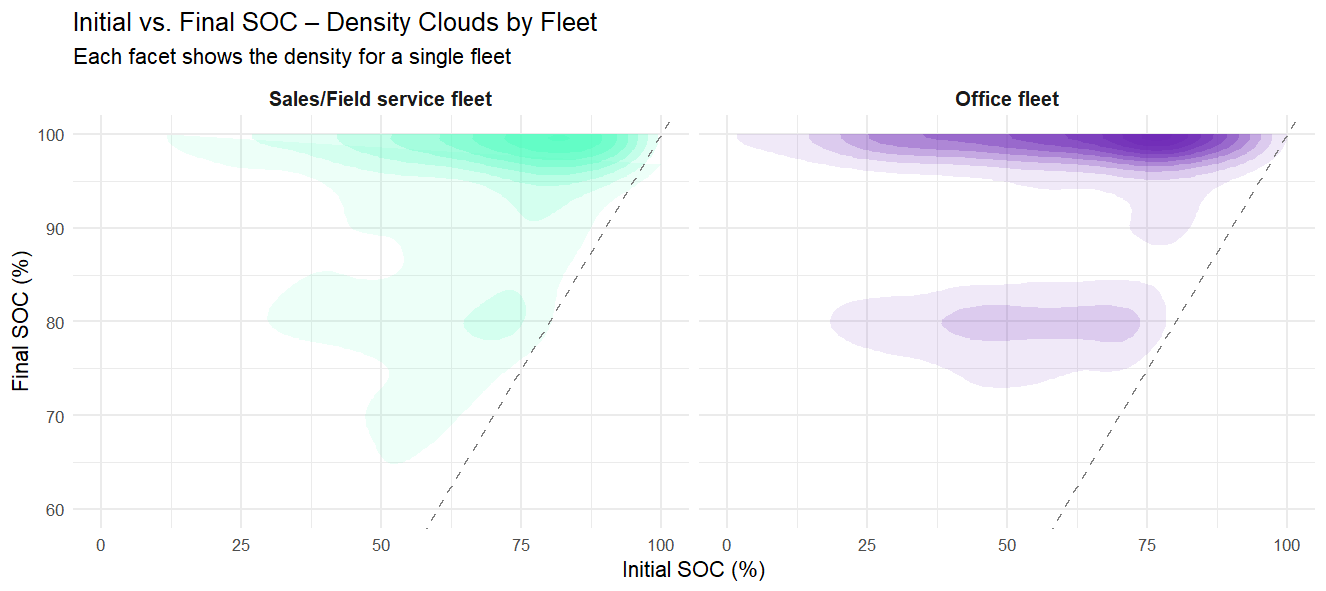Why charging at work is a key issue
With the growing use of electric vehicles, the workplace is becoming increasingly important as an important charging location. For companies that electrify their vehicle fleets, charging during working hours offers several advantages: Vehicles can be planned on company premises for several hours, users expect reliable charging points and the company can control the energy consumption.
But it is precisely this supposedly ideal starting point that also poses challenges: When many vehicles charge at the same time, there are peak loads and unnecessary electricity costs. It is therefore all the more important to understand the actual charging behavior and to use intelligent control concepts based on this.
How often do you charge at work anyway?
Our analyses show that not every fleet loads the same way.
In principle, corporate fleets can be divided into two groups: sales force fleets and office fleets. Sales representatives spend the majority of their time on the road. Your vehicles serve as a mobile work tool. They are less frequent at the company location during the day and therefore charge irregularly. Office vehicles, on the other hand, are regularly and for extended periods of time on company premises.
These different deployment patterns are clearly reflected in charging behavior: Office fleets charge twice as much energy at work as field service fleets.

When does charging take place?
A look at the course of the day shows that charging patterns follow a clear rhythm. Both office and field service fleets show a significant charging peak early in the morning, typically between 05:00 and 08:00, right when employees come to the office and connect their vehicle to the charging station first.

This routine has direct effects on network load and energy costs — and at the same time reveals untapped potential.
Rising electricity prices in the morning
At the start of work, many vehicles connect to the grid at the same time. This is a time when a lot of energy is traditionally required on the grid anyway. This results in so-called demand peaks, which are reinforced by a lower supply of renewable energy (especially photovoltaics). The result is rising electricity prices and a higher load on the grid connection.
For companies, this means that without active control, costs rise at exactly the hours when energy consumption is highest.
Unused charging potential in the afternoon
After the morning peak, charging activity levels off significantly. Many vehicles remain connected for the rest of the working day but are no longer actively charging. At the same time, PV production rises sharply from midday, just when cheaper electricity would be available. This time imbalance shows that a large part of the energy potential remains unused.
Intelligent charging management, not only related to building load management, could make targeted use of this phase — for example, by automatically moving charging processes to midday hours with low electricity prices. As a result, companies could both significantly increase their cost efficiency and, if they own their own PV system, maximize the self-consumption rate of their PV electricity.
Weekly patterns: energy demand follows work rhythm
Clear patterns can be seen not only throughout the day, but also throughout the week. At the beginning of the week — particularly on Monday and Tuesday — energy consumption is significantly higher. It decreases towards the end of the week.
This development reflects typical working habits: The start of the week is characterized by more office presence, while home offices or external appointments are increasing towards Friday. Flexible working time models and hybrid forms of work therefore directly influence the charging behavior of employees.
For companies, this means that charging infrastructure and energy planning must be increasingly adapted to these working patterns. A static system that assumes consistent use does not exploit its potential.


Cost factor: Charging at work remains attractive
Despite these challenges, charging at work remains particularly attractive from an economic perspective. On average, a kilowatt hour there costs around 23 centimes (median C4 tariff, Elcom) — compared to around 65 centimes at public charging stations.
This price advantage is a strong argument for companies to encourage their employees to invite them at work or at home, rather than in public spaces. At the same time, charging behavior follows fixed routines. Employees cannot be required to load at certain times or days — or even to come to the office at all. These individual patterns must therefore be respected but intelligently accompanied.
The data clearly shows that there is great potential for optimization between energy supply, charging behavior and work patterns. With data-based control solutions such as Smart Charging, we want to analyze and understand exactly these relationships. The aim is not only to optimize the energy load, but also to make the charging behavior smarter itself — without restricting employee flexibility.
The “safety charging” phenomenon
The observed charging behavior in the morning is closely linked to another routine that we constantly encounter in our everyday lives — the one we mentioned “Safety shop”.
Many drivers plug in their vehicles immediately after arriving at work, regardless of how full the battery is. Our data shows: The average start SoC (State of Charge) is often above 55%, which equates to an average of 250 km, and even higher for office fleets.
This means that a large part of the charging processes start even though the vehicle would actually still have enough energy for several trips. By way of comparison: On average, a person only travels around 30 kilometers per day by car (Source: Federal Statistical Office: Daily distance and travel time)
The behavior differs depending on the type of fleet:
- Office fleets show particularly distinctive safety charging behavior. Here, vehicles are plugged in regularly before work starts and are usually fully charged up to 100%.
- Field service fleets, on the other hand, have more variance in start and end SoC. Since these vehicles are used more frequently and often charge on the go, their charging behavior is more flexible and more demand-oriented, but less predictable.

Why do many charge so early and so full?
The reason is rarely the actual energy requirement, but mostly psychological safety: Many want to ensure that their vehicle is “ready” — for spontaneous trips, meetings or simply the good feeling of having enough range at the end of the day. This “range anxiety” means that vehicles are connected daily, even when there is no need.
What is rationally inefficient feels right for many drivers and therefore becomes routine.
Safety charging is a classic example of human habits that restrict technical efficiency.
As long as plugging in is part of the routine in the morning, charging behavior remains constant — even if the charging infrastructure becomes smarter and more flexible.
For companies, this means:
- Load management alone is not enough — drivers' behavior is another important key.
- Communication and user feedback are crucial for understanding routines and managing them in a targeted manner.
- Charging infrastructure planning can also be optimized: More charging points are often built than would actually be necessary if you take real charging behavior into account.
This is exactly where we start
With ChargeSmart, we are working intensively on questions such as:
- How often is the office store actually carried out per week?
- When is the ideal time to charge — from a network and user perspective?
- How can routines be designed in such a way that charging times remain flexible without losing convenience?
Our goal is not only to optimize energy loads, but also to make charging habits smarter so that charging at work is efficient, cost-effective and sustainable.




